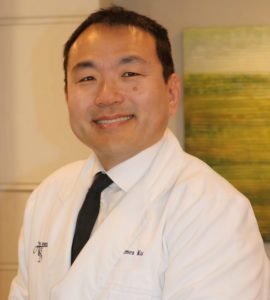IMPLANT DENTISTRY
Dental implants are the most technologically advanced tooth replacement option available to patients who have experienced tooth loss. Consisting of a root-like structure and a prosthetic crown component, the structural completeness of dental implants is the most effective replacement option for both form and function.
Dental Implant Placement
Dr. Ku places the dental implant, which is the small titanium cylinder that functions as the artificial tooth root, in the jaw in a surgical procedure. For the next several months after dental implant placement, the bone tissue in the vicinity will fuse with the implant’s titanium surface. Although dental implant placement does involve surgery, patients are usually able to resume most normal activities within a matter of days.
Dental Implant Restoration
After the dental implant has been osseointegrated, Dr. Ku will fit the patient with the restoration. In some cases, it may be possible to place the restoration at the time of implant placement, as well. Dental implants can replace a single tooth or multiple teeth, so that restoration may be a prosthetic crown, dental bridge or denture. The restorations supported by dental implants are specially designed to fit closely atop the implant. These restorations are made of materials that share many optical qualities with biological tooth enamel, so they look remarkably lifelike.
Benefits of Dental Implants
Dental implants have a number of benefits and advantages in comparison to conventional appliances. Because they can anchor the jaw in the same way a biological tooth’s root does, the likelihood of jawbone atrophy is much lower with an implant-supported appliance. This means that the jaw and the appliance are more stable over time. Patients with dental implants also can continue to chew a wide variety of foods, even fibrous ones like fresh fruits and vegetables. The connection between the bone and the implant allows for the toleration of stronger chewing forces, so dental implant patients won’t have to eliminate as many items from their diet. Also, because dental implants stand alone without support from neighboring teeth, it is unnecessary to alter surrounding teeth by placing crowns on them.
To learn more about the treatment process and benefits of implant dentistry, call our office and schedule a consultation.




